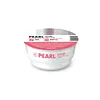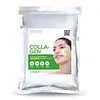What's inside
What's inside
 Key Ingredients
Key Ingredients

 Benefits
Benefits

 Concerns
Concerns

 Ingredients Side-by-side
Ingredients Side-by-side

Diatomaceous Earth
AbrasiveGlucose
HumectantCI 77231
Cosmetic ColorantAlgin
MaskingTetrapotassium Pyrophosphate
BufferingMagnesium Oxide
AbsorbentCellulose Gum
Emulsion StabilisingPearl Powder
Dehydroacetic Acid
PreservativeCI 77491
Cosmetic ColorantCitrus Aurantium Dulcis Oil
MaskingScutellaria Baicalensis Root Powder
AbrasiveAllantoin
Skin ConditioningEuterpe Oleracea Pulp Powder
AbrasiveCentella Asiatica Leaf/Stem Powder
Adenosine
Skin ConditioningPotassium Alginate
Emulsion StabilisingDiatomaceous Earth, Glucose, CI 77231, Algin, Tetrapotassium Pyrophosphate, Magnesium Oxide, Cellulose Gum, Pearl Powder, Dehydroacetic Acid, CI 77491, Citrus Aurantium Dulcis Oil, Scutellaria Baicalensis Root Powder, Allantoin, Euterpe Oleracea Pulp Powder, Centella Asiatica Leaf/Stem Powder, Adenosine, Potassium Alginate
Diatomaceous Earth
AbrasiveCI 77231
Cosmetic ColorantGlucose
HumectantAlgin
MaskingTetrapotassium Pyrophosphate
BufferingPotassium Alginate
Emulsion StabilisingAllantoin
Skin ConditioningAdenosine
Skin ConditioningHydrolyzed Collagen 0.02%
EmollientCitrus Junos Fruit Extract
Skin ConditioningCellulose Gum
Emulsion StabilisingMaltodextrin
AbsorbentSorbitan Fatty Acid Ester
EmulsifyingLactococcus Ferment
Skin ConditioningPortulaca Oleracea Extract
Skin ConditioningParfum
Masking
 Reviews
Reviews

Ingredients Explained
These ingredients are found in both products.
Ingredients higher up in an ingredient list are typically present in a larger amount.
Adenosine is in every living organism. It is one of four components in nucleic acids that helps store our DNA.
Adenosine has many benefits when used. These benefits include hydrating the skin, smoothing skin, and reducing wrinkles. Once applied, adenosine increases collagen production. It also helps with improving firmness and tissue repair.
Studies have found adenosine may also help with wound healing.
In skincare products, Adenosine is usually derived from yeast.
Learn more about AdenosineAlgin is brown algae. Algae is an informal term for a group of aquatic organisms that can photosynthesize. It is estimated there are at least 30,000 types of Algae.
Algae contains antioxidants. Antioxidants help fight free-radicals. Free-radicals are molecules that may damage your skin cells, such as pollution.
Allantoin is a soothing ingredient known for its protective and moisturizingg properties. Because of this, it is often added to products with strong active ingredients.
Studies show higher concentrations of this ingredient can promote wound healing.
Though it can be derived from the comfrey plant, allantoin is produced synthetically for cosmetic products to ensure purity.
Learn more about AllantoinCellulose Gum is a water-soluble polymer that comes from cellulose. It is used to change the texture of a product and to help stabilize emulsions.
As an emulsifier, cellulose gum specifically thicken the texture of water-based products.
This ingredient is considered hypoallergenic and non-toxic. Cellulose Gum can be found in cosmetics, food, and other household goods such as paper products.
Learn more about Cellulose GumWe don't have a description for CI 77231 yet.
Diatomaceous Earth is an exfoliant.
Glucose is a simple sugar and is the most important source of energy in all organisms.
In skincare, glucose is used to hydrate the skin. It also acts as a prebiotic for our natural biome.
Glucose is hydrating due to its humectant property. As a humectant, glucose draws moisture from the air and from deeper levels in the skin.
Our skin contains many sugars that act as prebiotics and help strengthen our natural microbiome. Having a healthy microbiome helps protect our skin from harmful bacteria and other contaminants.
Studies show glucose may help with fading discoloration and pigmentation. This is because our skin metabolizes glucose into lactic acid. Lactic acid is an AHA that helps exfoliate the top layer of skin.
Learn more about GlucoseWe don't have a description for Potassium Alginate yet.
We don't have a description for Tetrapotassium Pyrophosphate yet.